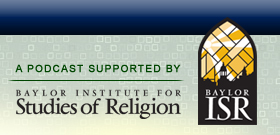

|
Keith Pavlischek on John Courtney Murray and Dignitatis Humanae  Date: February 28th, 2016
 With the 50th year anniversary of Dignitatis Humanae three months past, the speedy staff at Research on Religion finally get around to celebrating this monumental document with Dr. Keith Pavlischek, a former Marine Corps officer and author of John Courtney Murray and the Dilemma of Religious Toleration. For those not in the know, Murray was an American Jesuit and theologian whose writings helped to set debate for the Vatican’s new direction with respect to religious freedom and church-state relations. We begin with a summary of the importance of Dignitatis Humanae in Catholic history and Dr. Pavlischek notes that while it was not a radical disestablishmentarian document, it did bring Church thinking up to date with respect to civil liberties for religious minorities and began to recast how the Holy See would see the role of the state in promoting toleration of religion. We spend time discussing the notion of toleration and Keith reminds us that toleration is not about being forced into liking something, but rather being to live with others who have views you may not like. Keith and Tony then jump into the history of John Courtney Murray, a Trinitarian theologian who is drawn into issues of religious liberty by a number of Supreme Court decisions in the 1940s, including Everson v Board of Education (1947) and McCollum v Board of Education (1948)that many Catholics saw as an affront to their ability to educate their children. Being a religious minority within a Protestant nation shaped the thinking of Murray on the issue of toleration. Interestingly, Murray’s thought takes a novel direction that argues against both radical secularists and conservative Catholics, forging a new stream of thinking. While he was regularly attacked in the pages of the American Ecclesiastical Review, Murray rose to prominence in Catholic thought earning a cover story in Time Magazine and an invitation to the Second Vatican Council. Dr. Pavlischek lays out Rev. Murray’s “dilemma of religious toleration,” which revolves around how one can tolerate religious views that one considers to be demonstrably wrong. At the time, there were a few arguments favoring religious freedom including the “modus vivendi” approach and the “thesis-hypothesis” perspective. The former makes a pragmatic argument that in a diverse society it makes sense to accept differences of opinion so as to avoid social conflict. The latter “thesis-hypothesis” thesis was more favored by Catholic intellectuals who hoped that the Church could work to promote a more Catholic society and then eventually move towards having a state church when their faith prevailed. Murray sought to ground a permanent tolerance within a moral framework, relying upon medieval Catholic thought and arguing for the preservation of a broad moral (Christian) consensus within society. Murray concerned himself with the decline of a moral consensus within American society in the 1950s and early ’60s by people he called “barbarians in Brooks Brothers suits.” We discuss how the concepts of subsidiarity and Galician dualism form the basis for Murray’s thinking and how this then influenced the debate at Vatican II. We finish with some of Dr. Pavlischek’s thoughts on what he learned in the process of writing the book and how he might have changed or amended it in the 20 years since it was published. This brings up a brief discussion of how Islam may have a problem with issues of religious toleration given its monistic (as compared to dualistic) theology. Keith also notes how Murray ended his life on a very pessimistic tone with cultural changes occurring in American society and how he might be very concerned about the direction of the US in contemporary times. Recorded: February 15, 2016.
Leave a Reply |
 Search The Podcast
To search the podcast, type a term and click the Search button.
  Browse Podcast Categories
Select a category below to browse the podcast:
   |














